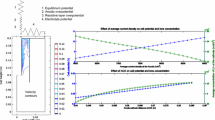Abstract
A model of a gas-evolving production-type cell with a circularly perforated anode is described. A unit of the model was composed of a disk cathode, a separator and a ring anode in turn. These were located in a cylindrical cell filled with solution. Primary current and potential distributions in the unit cell were computed by solving the Laplace equation in cylindrical coordinates by the finite element method. Geometric parameters determining the distributions were primarily the interelectrode distance and the percentage open area. Current distribution in the open part was larger than that in a rectangular cell with the same geometric parameters because of the cylindrically concentrated supply of the current from the inner part of the ring and the back side of the anode. The unit cell resistance was evaluated as a function of the geometric parameters. It exhibited a linear variation of the interelectrode distance and the square of the percentage open area. There was, however, a slight dependence of the percentage open area on the unit cell resistance and hence it is concluded that circularly perforated electrodes provide higher performance than louvre-type electrodes.
Similar content being viewed by others
Abbreviations
- d 1 :
-
distance between the front side of the anode and the separator
- d 2 :
-
thickness of the separator
- H :
-
height of the anode on a large scale
- I :
-
total current in the unit cell
- i :
-
current density
- p :
-
pitch, i.e. diameter of the cylindrical unit cell
- R :
-
unit cell resistance, defined by Equation 13
- R 1 :
-
total cell resistance in a cell on a large scale
- r :
-
radial length in the cylindrical coordinate
- s :
-
superficial surface area, given by Equation 2
- t :
-
thickness of the anode
- υ:
-
test function
- W :
-
width of the anode in a cell on a large scale
- w :
-
width of the anode of the unit cell
- z :
-
axial length in the cylindrical coordinate
- dγ:
-
infinitesimal length on the boundary
- ϱ:
-
resistivity
- ϕ:
-
potential
- ϕ* :
-
potential at the anode
- Γ:
-
linear integration contour
- Ω:
-
double integration space
- ν:
-
length normal to the boundary
- a:
-
anode
- c:
-
cathode
- cy:
-
cylindrical model
- rc:
-
rectangular model
- 1:
-
solution phase
- 2:
-
separator phase
References
C. Kasper,Trans. Am. Electrochem. soc 78 (1940) 131, 147,82 (1942) 152.
S. Ishizaka and H. Matsuda,Denkikagaku 19 (1951) 89.
H. Matsuda and S. Ishizaka,Denkikagaku 20 (1952) 38, 84.
S. Ishizaka, H. Matsuda and Y. Wada,Denkikagaku 22 (1954) 420.
C. Wagner,J. Electrochem. Soc.,98 (1951) 116; 99 (1952) I.
C. W. Tobias,J. Electrochem. Soc. 106 (1959) 833.
S. Komagata,Denki Shikenjo Kenkyu Houkoku No. 294 (1930).
C. W. Tobias and R. Wijman,J. Electrochem. Soc. 100 (1953) 459.
P. Robertson,Electrochim. Acta 22 (1977) 411.
Y. Nishiki, K. Aoki, K. Tokuda and H. Matsuda,J. Appl. Electrochem. 17 (1987) 445.
K. Aoki, Y. Nishiki, K. Tokuda and H. Matsuda,J. Appl. Electrochem. 17 (1987) 552.
Y. Nishiki, K. Aoki, K. Tokuda and H. Matsuda,J. Appl. Electrochem. 16 (1986) 615.
G. A. Prentice and C. W. Tobias,J. Electrochem. Soc. 129 (1982) 72.
A. D. Martin, A. A. Wragg and J. C. R. Turner,Inst. Chem. Eng. Symp. Ser. 98 (1986) 38.
A number of reports have been presented, especially for mass transport in cells. For example, I. Rousar, V. Cezner, J. Nejepsova, M. M. Jacksic, M. Spasojevic and B. Z. Nikolic,J. Appl. Electrochem. 7 (1977) 427.
Y. Nishiki, K. Aoki, K. Tokuda and H. Matsuda,J. Appl. Electrochem. 14 (1984) 653.
Y. Nishiki, K. Aoki, K. Tokuda and H. Matsuda,J. Appl. Electrochem. 16 (1986) 291.
Y. Nishiki, K. Aoki, K. Tokuda and H. Matsuda,J. Appl. Electrochem. 17 (1987) 67.
Y. Nishiki, S. Nakamatsu, K. Aoki and K. Tokuda,J. Electrochem. Soc. 19 (1989) 90.
J. Dukovic and C. W. Tobias,J. Electrochem. Soc. 134 (1987) 331.
O. C. Zienkiewich, ‘The Finite Element Method’, McGraw-Hill, London (1977).
Author information
Authors and Affiliations
Rights and permissions
About this article
Cite this article
Aoki, K., Nishiki, Y. Computation of primary current distribution and cell resistance at model electrodes with circular perforations. J Appl Electrochem 19, 183–187 (1989). https://doi.org/10.1007/BF01062298
Received:
Revised:
Issue Date:
DOI: https://doi.org/10.1007/BF01062298




